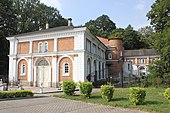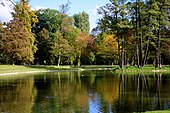Strzelce Opolskie
Strzelce Opolskie | |
|---|---|
 Town hall | |
 Flag  Coat of arms | |
 Strzelce Opolskie | |
| Coordinates: 50°30′N 18°17′E / 50.500°N 18.283°ECoordinates: 50°30′N 18°17′E / 50.500°N 18.283°E | |
| Country | |
| Voivodeship | Opole |
| County | Strzelce |
| Gmina | Strzelce Opolskie |
| First mentioned | 13th century |
| Government | |
| • Mayor | Tadeusz Goc |
| Area | |
| • Total | 30.13 km2 (11.63 sq mi) |
| Population (2019-06-30[1]) | |
| • Total | 17,900 |
| • Density | 590/km2 (1,500/sq mi) |
| Time zone | UTC+1 (CET) |
| • Summer (DST) | UTC+2 (CEST) |
| Postal code | 47-100 |
| Car plates | OST |
| National roads | |
| Voivodeship roads | |
| Website | http://www.strzelceopolskie.pl |
Strzelce Opolskie [ˈstʂɛlt͡sɛ ɔˈpɔlskʲɛ] (![]() listen) (German: Groß Strehlitz, Silesian: Wielge Strzelce) is a town in southern Poland with 17,900 inhabitants (2019), situated in the Opole Voivodeship. It is the capital of Strzelce County.
listen) (German: Groß Strehlitz, Silesian: Wielge Strzelce) is a town in southern Poland with 17,900 inhabitants (2019), situated in the Opole Voivodeship. It is the capital of Strzelce County.
Demographics[]
Strzelce Opolskie is one of the biggest centers of German minority in Poland.
Transport[]
The town is located along the major rail line which joins Gliwice and Opole. Until 1999, there was a branch line connecting Strzelce Opolskie with Kędzierzyn Koźle. It closed as part of PKP's cost-cutting measures, although the rails still (2006) remain in site.
The town is located on the Polish National road No. 94, and the Voivodeship roads 409 and 426.
History[]

The settlement was mentioned in 13th-century documents, when it was part of Piast-ruled Poland. It received town rights probably in the 13th century. Local dukes of the Piast dynasty erected a castle in the town.
The town was annexed by Prussia in the 18th century, and then from 1871 to 1945 it was also part of Germany. According to the German census of 1890, it had a population of 5,112, of which 500 (9.8%) were Poles.[2] In the Upper Silesia plebiscite held in 1921, the residents were asked to choose between remaining in Germany and joining Poland. In Groß Strehlitz, 85.7% of the votes were cast in favour of remaining in Germany.
Polish activists were persecuted intensively since 1937.[3] In April and May 1939, multiple German attacks on Poles took place in the town.[4] Nazi German militants attacked the actors of the Polish theater from Katowice and the gathered Polish public, and demolished the theater hall of the Polish bank.[4] The Hitler Youth devastated the headquarters of Polish organizations, Polish enterprises (bank and cooperative) and houses of local Polish activists.[4] In August and September 1939, the Germans carried out arrests of prominent local Poles, including chairmen of the Polish bank, cooperative and local branch of the "Sokół" Polish Gymnastic Society, and confiscated the assets of the Polish bank.[5] During World War II, Nazi Germany operated a detention center where it would send prisoners to forced labour.[6] Many died from exhaustion and/or starvation. Among the prisoners were Poles arrested for rescuing Jews from the Holocaust.[7] The Germans also operated a labour subcamp of the Stalag VIII-B/344 prisoner-of-war camp,[8] and a forced labour camp for Jews.[9] After the defeat of Germany in the war in 1945, the town became again part of Poland.
Sports[]
The local football club is Piast Strzelce Opolskie with men and women sections.[10] Both sections compete in the lower leagues.
Notable people[]
- Gustav Meyer (1850-1900), linguist and notable Albanologist
- Helmuth Förster (1889–1965), general
- Heinz Kokott (1900–1976), general
- Hermann Bix (1914–1986), officer
- Erich Mende (1916–1998), politician
- Piotr Domaradzki (1946–2015), journalist, essayist and historian
- Mirosław Sekuła (born 1955), chemist and politician
- Sławomir Szmal (born 1978), handball player
Twin towns – sister cities[]
See twin towns of Gmina Strzelce Opolskie.
Gallery[]

Town hall
Castle park
Ruins of the Piast Dukes' Castle, 14th century

Old stable of the castle complex
Monument to the victims of wars
See also[]
References[]
- ^ "Population. Size and structure and vital statistics in Poland by territorial division in 2019. As of 30th June". stat.gov.pl. Statistics Poland. 2019-10-15. Retrieved 2020-02-14.
- ^ "Deutsche Verwaltungsgeschichte Schlesien, Kreis Gross-Strehlitz". treemagic.org. Retrieved 2021-01-19.
- ^ Cygański, Mirosław (1984). "Hitlerowskie prześladowania przywódców i aktywu Związków Polaków w Niemczech w latach 1939-1945". Przegląd Zachodni (in Polish) (4): 24.
- ^ Jump up to: a b c Cygański, p. 26-27
- ^ Cygański, p. 32-34
- ^ "Zuchthaus und Haftanstalt Sicherungsanstalt Groß Strehlitz". Bundesarchiv.de (in German). Retrieved 2 January 2021.
- ^ Rejestr faktów represji na obywatelach polskich za pomoc ludności żydowskiej w okresie II wojny światowej (in Polish). Warszawa: IPN. 2014. pp. 75, 97, 99.
- ^ "Working Parties". Lamsdorf: Stalag VIIIB 344 Prisoner of War Camp 1940 - 1945. Retrieved 2 January 2021.
- ^ "Zwangsarbeitslager für Juden Groß Strehlitz". Bundesarchiv.de (in German). Retrieved 2 January 2021.
- ^ "Piast Strzelce Opolskie - strona klubu" (in Polish). Retrieved 22 May 2021.
External links[]
- Jewish Community in Strzelce Opolskie on Virtual Shtetl
| Wikimedia Commons has media related to Strzelce Opolskie. |
- Cities and towns in Opole Voivodeship
- Strzelce County
- Cities in Silesia








